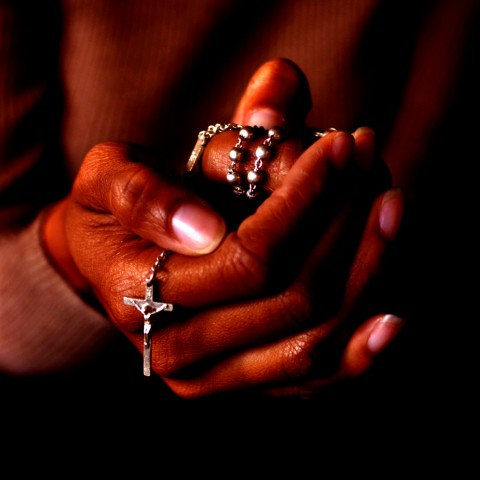October is traditionally known as the month of the Rosary, as the Feast of Our Lady of the Rosary falls then (October 7th). The Rosary has been a deeply loved Catholic prayer for many centuries, and in its present form dates from the Middle Ages in Europe. Its use was greatly encouraged by the friars at that time – its origin is associated with St Dominic in the 13th century – so it has a long venerable tradition.
If we remember that in the Middle Ages very few people could read, and books were very expensive to produce (all were hand-copied) so a simple way of helping people to pray was a really important help to developing people’s spirituality and knowledge of the faith. To pray the Rosary people only had to remember a few very familiar prayers and fifteen very significant events in the New Testament, all of which were known because of the Church’s holy days. So people had an easy guide to their prayer which gave it a structure, helped them appreciate the working of God and ponder the life of Jesus and Mary.
Those who were members of the great monasteries and convents which covered Europe in the Middle Ages, would devote significant parts of each day to prayer for the Church and for the world, and the main prayers they used for that were the Psalms of the Old Testament – prayers that we know our Lord used. There are 150 Psalms in the Old Testament, and so these were the staple prayers of those who gathered in prayer in the churches and chapels of religious houses. As we noted, most people had neither the ability to read, nor the opportunity to gather formally for lengthy periods of prayer, but the Rosary which included 150 “Hail Marys” was, in some ways, the equivalent for those who could pray as they went about their day.
The traditional fifteen “mysteries of the Rosary” – three sets each of five events divided into joyful, sorrowful, and glorious mysteries – plus the extra five instigated by Pope John Paul II – give a simple focus for reciting the “Our Father”, ten “Hail Marys” and the Glory be. The important point of reciting the prayers is the pondering of the event (mystery) it refers to. So in reciting the mystery of the Annunciation we are invited to contemplate the visit of the Archangel Gabriel to Mary, carrying the extraordinary news that she was to be the Mother of the Saviour. In reciting the prayers for the mystery of the agony in the garden we are invited to reflect on the Lord on the Mount of Olives preparing for his crucifixion. When we pray the mystery of the Ascension, we ponder the Lord taken up to the Father in glory. All the events that are recorded in the mysteries of the Rosary are key moments of our history of salvation, marking the great moments recorded in the scriptures.
Sometimes we can pray the Rosary as a group – praying with other people is always a bonus. Sometimes we can pray the Rosary as we walk on our way or as we are engaged in some repetitive or mechanical task. The gentle constant repetition of the words can have a calming and positive effect on us (especially when we have hectic lives!) The ideal is, of course, to make sure we do use the time to indeed contemplate the Mystery we are praying, to truly give our mind and heart over to pondering the birth of the Lord, or his carrying of the cross, or his resurrection, as the Mystery dictates.
Some people find the rosary dull or simply a chore – we all have different ways of praying, but like all prayer the Rosary is ultimately simply an invitation to spend time with the Lord, aware of his love and mercy and uniting ourselves with him in his life among us. That is something we don’t need to do just in October, but making the effort this month can help deepen our life of prayer.

